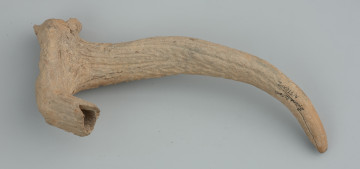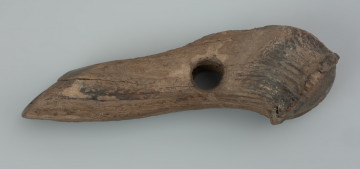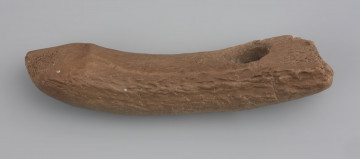
Holder
9600 p.n.e. — 5400 p.n.e.
National Museum in Szczecin
Part of the collection: Stone Age
The hoe made of red deer antlers was discovered in unknown circumstances on Grodzka Island in Szczecin in 1938. The raw material, the left beam of a medium-sized male, was recovered from one hunted in late summer or autumn, as evidenced by the remains of the pedicle, namely, a bony protuberance on the skull from which the antlers grow. First, the antlers and the pedicle were cut off from the skull, then the two front roe deer antlers, the brow tine and the bay antler were sawn off. Finally, a transverse blade was shaped, and a hole for the shank was drilled, the sequence of which is not precise. Part of the process of making the tool was to remove the pearling of the rose and break off and bevel the remains of the roe deer antlers. A flint punch was probably used for this. It is interesting in that; firstly, it required the antlers to be softened over a long period of time before the hoe was made and, secondly, the technique used is relatively rare for Mesolithic monuments. Abrasion, scraping and planing were used much more frequently instead of chipping off, and in most cases, the pearling was not removed from the antler objects. The hoe bears the marks of very intensive and long-lasting use on its blade and hilt. It was only abandoned when it broke during earthworks. The antlers of deer and other animals were a raw material commonly used by hunter-gathering communities in the Stone Age. After prolonged soaking causing softening, it was easily worked with flint tools. After drying, it became hard again.
Michał Adamczyk
Author / creator
Dimensions
cały obiekt: height: 21 cm, width: 5.6 cm
Object type
hoe
Technique
cutting, drilling, breaking, setting, chopping, softening
Material
red deer antlers
Origin / acquisition method
acquisition
Creation time / dating
Creation / finding place
Owner
National Museum in Szczecin
Identification number
Location / status

9600 p.n.e. — 5400 p.n.e.
National Museum in Szczecin

7000 p.n.e. — 5400 p.n.e.
National Museum in Szczecin

9600 p.n.e. — 5400 p.n.e.
National Museum in Szczecin
DISCOVER this TOPIC
National Museum in Szczecin
DISCOVER this PATH
Educational path